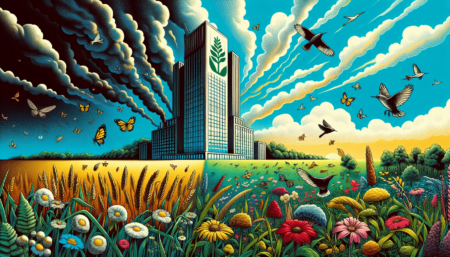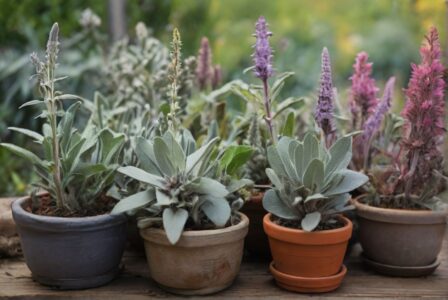- A brief overview of the problems of corporations such as Monsanto and others for biodiversity
- The role of Bayer-Monsanto in global agriculture
- Effects of glyphosate and genetically modified organisms (GMOs)
- Criticism and resistance
- Sustainable alternatives to conventional agriculture
- Conclusion and outlook
1. a brief overview of the problems of corporations such as Monsanto and others for biodiversity
- The use of pesticides leads to a significant reduction in biodiversity in agricultural landscapes. Fields treated with pesticides have only half as much biodiversity as organically farmed fields [1].
- While pesticides increase crop yields, a complex dilemma arises between biodiversity and yield. This highlights the need to find alternatives that both increase productivity and preserve biodiversity [1].
- Genetically modified organisms (GMOs) may lead to a slight reduction in the use of insecticides, but result in a significant increase in herbicide use. This emphasizes the importance of developing technologies that are not based on chemical pesticides to control pests and weeds in agriculture [1].
- Neonicotinoids, which are 1000 times more toxic than DDT, primarily harm pollinators and thus reduce the yield of fruit and other crops [2]. Glyphosate, a probable carcinogen, destroys food sources for herbivores in ecosystems, leading to a loss of biodiversity [2].
- The weak approval practice for pesticides in the EU, which does not take into account whole groups of organisms such as amphibians and overlooks the effects of pesticide cocktails, underlines the urgency of stricter regulations and a permanent ban on neonicotinoids as well as stricter regulations for glyphosate [2].
- The LBV emphasizes the importance of preserving bee populations and calls for independent research into the safety of pesticides. This underlines the need to reduce pesticide use and support integrated pest management strategies [2].
- A study on herbicide-resistant oilseed rape, sugar beet and maize plants showed a significant decrease in the number of wild flowers and seeds, affecting insect populations for herbicide-resistant oilseed rape and sugar beet. Herbicide-resistant maize showed an increase in biodiversity compared to conventional maize, but this is not applicable due to the ban on atrazine in Germany or the EU [3].
- The massive use of glyphosate in the USA has led to a decline in the population of the monarch butterfly. The monarch butterfly caterpillars' main food source, milkweed, has declined by 99% in the monarch's main breeding area. This has also had a negative impact on the butterfly's breeding and migration patterns [3].
2. the role of Bayer-Monsanto in global agriculture
- Takeover by Bayer
- In June 2018, Bayer, a German chemical company, acquired Monsanto, a US-based genetically modified seed company, for around €56 billion [4].
- This merger made Bayer the largest player in the global agriculture industry, controlling around 60% of the commercial seed and global pesticide market together with two other mega-corporations [4].
- Impact on small farmers and biodiversity
- Market concentration and political influence
- If all planned mergers (Bayer-Monsanto, Syngenta-ChemChina, Dow-DuPont) go through, three companies would dominate about 60% of the global commercial seed market and 65% of the global pesticide market [6].
- The increasing market concentration also gives these companies more political influence in international organizations such as the FAO and CBD [6].
- Emphasis is placed on strengthening farmers' rights, seed sovereignty and agroecological practices to ensure food security and equity [6].
This merger between Bayer and Monsanto is a turning point in global agriculture that has far-reaching implications for small farmers, biodiversity and the political landscape. The importance of agroecological practices and stronger regulation of the market power of such mega-corporations becomes particularly clear in this context.
3. effects of glyphosate and genetically modified organisms (GMOs)
- Direct toxic effects of glyphosate on non-target species
- Lethal effects on aquatic organisms, some of which may lead to population decline [7].
- Sublethal effects on terrestrial organisms that impair their reproductive capacity and growth rates [7].
- Negative effects on the biological characteristics of beneficial insects, which can impair pollination performance and natural pest control [7].
- Indirect effects of glyphosate on non-target species
- Reduction of surrounding vegetation, resulting in a reduced food supply and habitat for a variety of species [7].
- Increased herbicide applications, which can lead to the development of resistance in weeds, which in turn leads to even more intensive use of glyphosate [7].
- Reduced activity and reproduction of earthworms, which has a negative impact on soil fertility and structure [7].
- Negative impact on the reproductive success of birds and mammals, which can contribute to a decline in biodiversity [7].
- Global impact of glyphosate and GMOs
- Glyphosate-resistant weeds are a significant problem, particularly in the US, with 50 species identified worldwide by 2020, highlighting the need to move away from reliance on single herbicides [12].
- Around 160 million hectares of genetically modified soy, maize, cotton and rapeseed are cultivated worldwide, of which around three quarters are herbicide-resistant. This leads to increased use of glyphosate and exacerbates the problem of resistant weeds [11].
- Glyphosate contamination in soils and waterways poses risks to aquatic life and disrupts the delicate balance of ecosystems, ultimately leading to a decline in essential pollinators such as bees and other insects that are critical to crop pollination and overall ecosystem health [15].
4. criticism and resistance
- Resistance and criticism from farmers' networks
- The MASSIPAG network, led by farmers, is resisting companies like Monsanto by using improved local varieties and developing their own rice varieties, breaking the dependence on seed companies [16].
- Legal challenges and public rejection
- Despite the rejection of genetically modified food by three quarters of EU citizens, this practice continues [11].
- The so-called "Monsanto Law" in Guatemala met with considerable criticism and resistance from various sectors of society, as it threatened food security and had a negative impact on the economic situation of farmers [17].
- The law grants intellectual property rights to those who "develop" or "discover" plant varieties through genetic manipulation, which can lead to a monopolization of the seed supply [17].
- The law was passed without prior consultation with the general population or indigenous groups, which is a violation of ILO Convention 169 [17].
- The law could make it illegal to possess and transport seeds without the manufacturer's permission, with penalties including imprisonment [17].
- The law is seen as a threat to the natural cycle of plant life and reproduction and could lead to the control of Guatemala's biodiversity by national and foreign companies [17].
- Opposition and lobbying
- Monsanto has faced strong opposition from anti-GMO activists in Europe, leading the company to halt applications for new EU approvals for genetically modified crops [13].
- Monsanto is accused of intensive lobbying to promote its interests in politics and with regulatory authorities [13].
- The merger of Bayer and Monsanto contributes to a technology that promotes monocultures and eliminates natural vegetation, damaging soil health, reducing biodiversity and endangering human health through the use of harmful pesticides [18].
- Patent issues with Monsanto and Bayer's aggressive patenting of seeds, fruits and vegetables threaten global food diversity and security, particularly undermining the position of small farmers in developing countries [18].
5. sustainable alternatives to conventional agriculture
- Reduced tillage
- By reducing tillage, the soil structure is preserved and the organic matter content increases, which can lead to improved water retention and higher soil fertility [19].
- Intercropping
- The cultivation of catch crops helps to prevent soil erosion, suppresses weeds and promotes biodiversity in the soil. This practice can also help to reduce the need for chemical fertilizers and pesticides [19].
- Crop rotation
- Rotating crops each season can improve soil health, reduce pest pressure and increase overall productivity. A diverse crop rotation can also contribute to the preservation of biodiversity [19].
- Mulching
- Mulch suppresses weeds, conserves soil moisture and improves soil structure. This method also helps to regulate the soil temperature and reduce water consumption [19].
- Agroecological methods
- Agroecological practices emphasize democratic, local and environmentally friendly farming methods. They aim to increase productivity, reduce dependence on chemical inputs and promote biodiversity [20].
- Preservation of local seed varieties
- The preservation of regional seed varieties supports the maintenance of biodiversity and promotes sustainable agriculture. Local seeds are often better adapted to local conditions and can play an important role in adapting to climate change [21].
- Organic farming
- Organic farming can help combat malnutrition, hunger and environmental degradation by promoting fair trade, solidarity and organic methods. These methods reduce dependence on chemical fertilizers and pesticides and promote healthier ecosystems [21].
- New European partnership for agroecology research
- This partnership focuses on research into agroecology, with the aim of better understanding the root system and promoting sustainable agricultural practices. Such research initiatives can help lay the foundations for more sustainable agriculture [22].
- Biologicals for agriculture
- Biologicals, biological molecules or cells that are used as active ingredients in agriculture sustainably improve the health of plants, animals and soils. These approaches can help to reduce dependence on chemical pesticides and minimize environmental pollution [22].
- Molecular filters made from chiral membranes
- These filters can help create more sustainable products by reducing waste and lowering environmental impact. They offer an innovative solution for the purification of water and other liquids in agriculture and beyond [22].
Implementing these practices requires a move away from reliance on single herbicides, which tend to develop resistance over time. Integrated pest management strategies that include diverse crop rotations, mixed cropping, intercropping and moderate herbicide use with herbicide-tolerant crops are recommended to promote sustainable agriculture and ensure long-term food security [12].
- These filters can help create more sustainable products by reducing waste and lowering environmental impact. They offer an innovative solution for the purification of water and other liquids in agriculture and beyond [22].
6 Conclusion and outlook
Critical examination of the impact of Monsanto and similar companies on biodiversity and global agricultural practices has highlighted both the negative consequences of the massive use of pesticides and genetically modified organisms and the need for more sustainable agricultural practices. The merger between Bayer and Monsanto illustrates the deepening links between large corporations and global food production, which raises significant ethical, environmental and economic issues. The fact that the use of certain substances such as glyphosate and the practices of seed monopolization cause direct damage to non-targeted species and contribute to the development of resistance underlines the need for a shift towards a more holistic approach to agriculture.
In light of the problems highlighted, it is crucial that a rethink takes place in the field of agricultural science as well as in politics and policy. The promotion of sustainable alternatives such as organic farming, agroecological practices and the preservation of local seed varieties offers ways in which we can protect biodiversity and at the same time strengthen food security on a global level. We need to reduce dependence on chemical substances and instead use methods that support the environment and the diversity of species. The role of every individual, community and policy maker in this transformation process is essential to ensure a sustainable and equitable use of our planet's resources.
More questions and answers about Monsanto and co.
What is Monsanto's main activity?
Monsanto is the world's largest seed producer and often uses genetically modified products. The company is also known for selling crop protection products, in particular the controversial herbicide Roundup, which contains the active ingredient glyphosate. Monsanto employs over 20,000 people.
Why is Bayer responsible for Monsanto?
Bayer bears responsibility for Monsanto, as legal disputes arose following the takeover of the company. In the USA, Bayer suffered a legal defeat in a court case concerning the weedkiller Roundup. A jury in Philadelphia sentenced Monsanto to pay damages of 2.25 billion dollars, which corresponds to around 2.1 billion euros.
Why is glyphosate considered dangerous?
Studies have shown that glyphosate can have mutagenic and genotoxic effects. In March 2015, the International Agency for Research on Cancer (IARC) of the World Health Organization (WHO) classified glyphosate as a Group 2A carcinogen, which means that it is "probably carcinogenic to humans".
What price did Bayer pay for the takeover of Monsanto?
In 2018, Bayer acquired its American competitor Monsanto for the enormous sum of 63 billion euros. This acquisition was financially very challenging and led to Bayer having to take on significant debt. The CEO at the time, Werner Baumann, saw this acquisition as a measure to protect Bayer from a possible takeover by Monsanto.
Further links
- https://www.arche-noah.at/politik/vielfalt-statt-viel-macht/faqs/
- https://www.regenwald.org/petitionen/1122/weg-mit-roundup-und-glyphosat
- https://www.slowfood.com/blog-and-news/glyphosate-the-weedkiller-thats-killing-us/
Youtube
References
[1] – https://www.zeit.de/wissen/umwelt/2010-02/landwirtschaft-pestizide-artenvielfalt
[2] – https://www.lbv.de/naturschutz/standpunkte/landwirtschaft/pestizide/
[3] – https://www.bund.net/themen/landwirtschaft/gentechnik/risiken/herbizidresistente-pflanzen/
[4] – https://www.inkota.de/themen/welternaehrung-landwirtschaft/bayer-monsanto-co
[5] – https://www.spiegel.de/spiegel/bayer-monsanto-fusion-das-sind-die-folgen-fuer-die-welternaehrung-a-1199860.html
[6] – https://www.misereor.de/fileadmin/publikationen/bayer-monsanto-bleibt-uns-vom-acker.pdf
[7] – https://www.bfn.de/sites/default/files/2021-04/20180131_BfN-Papier_Glyphosat.pdf
[8] – https://www.misereor.de/fileadmin/publikationen/publikation-advancing-together-ein-jahr-bayer-monsanto-eine-kritische-bilanz.pdf
[9] – https://blog.de.erste-am.com/eine-geschichte-zweier-unternehmen-bayers-biodiversitaetsproblem-mit-monsanto/
[10] – https://www.deutschlandfunk.de/umstrittene-fusion-von-bayer-und-monsanto-neue-aera-fuer-100.html
[11] – https://www.ugb.de/lebensmittel-im-test/glyphosat/
[12] – https://www.transgen.de/anbau/1429.resistente-superunkraeuter-gentechnik.html
[13] – https://rp-online.de/leben/gesundheit/news/warum-monsanto-so-umstritten-ist_aid-15263967
[14] – https://de.wikipedia.org/wiki/Monsanto
[15] – https://www.regenwald.org/petitionen/1069/giftkonzerne-bayer-monsanto-stoppen
[16] – https://www.cidse.org/de/2016/10/27/farmers-regaining-control-of-their-seeds-the-alternative-to-monsanto-in-the-philippines-2/
[17] – https://www.npla.de/thema/arbeit-gesundheit/widerstand-gegen-monsanto-gesetz/?pk_campaign=feed&pk_kwd=widerstand-gegen-monsanto-gesetz
[18] – https://gruene-nrw.de/2018/06/marktmacht-der-agrochemie-konzerne-begrenzen-artenvielfalt-nahrungssicherheit-und-arbeitsplaetze-erhalten/
[19] – https://www.greens-efa.eu/files/assets/docs/alternativen_zu_pestiziden_in_der_landwirtschaft_der_fall_glyphosat.pdf
[20] – https://www.wiwo.de/unternehmen/industrie/monsanto-geht-an-bayer-es-gibt-funktionierende-alternativen/21097128-2.html
[21] – https://kontrast.at/vandana-shiva-saatgut-monsanto-nestle/
[22] – http://biooekonomie.de/themen/dossiers/biologika-fuer-die-landwirtschaft
[23] – https://institut-fuer-welternaehrung.org/monsanto-ist-bayer-und-nun-kommentar-von-wilfried-bommert
[24] – https://www.bund.net/themen/aktuelles/detail-aktuelles/news/bayer-monsanto-fusion-wer-die-saat-hat-hat-das-sagen/
[25] – https://www.brot-fuer-die-welt.de/pressemeldung/2017-mega-fusion-bayer-monsanto-bringt-baeuerliche-landwirtschaft-unter-druck-industrielles-saatgut-und-pestizide-schaffen-neue-abhaengigkeiten/
















